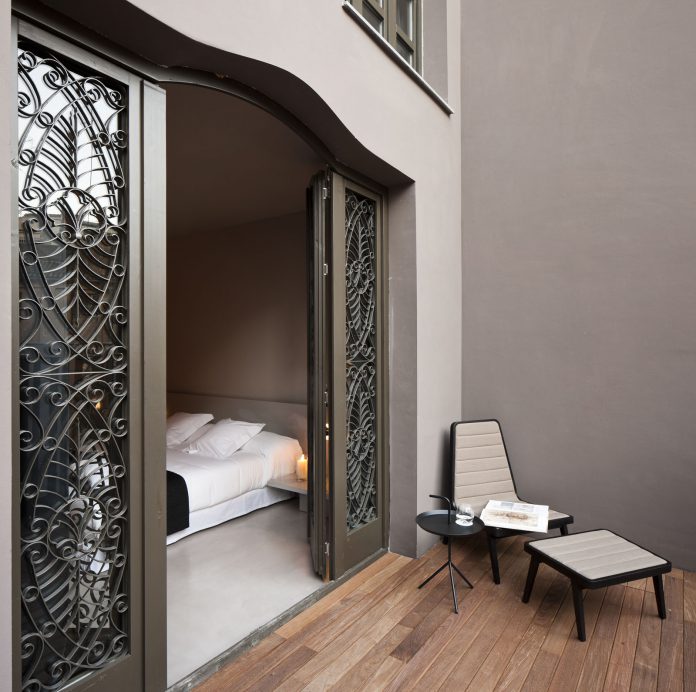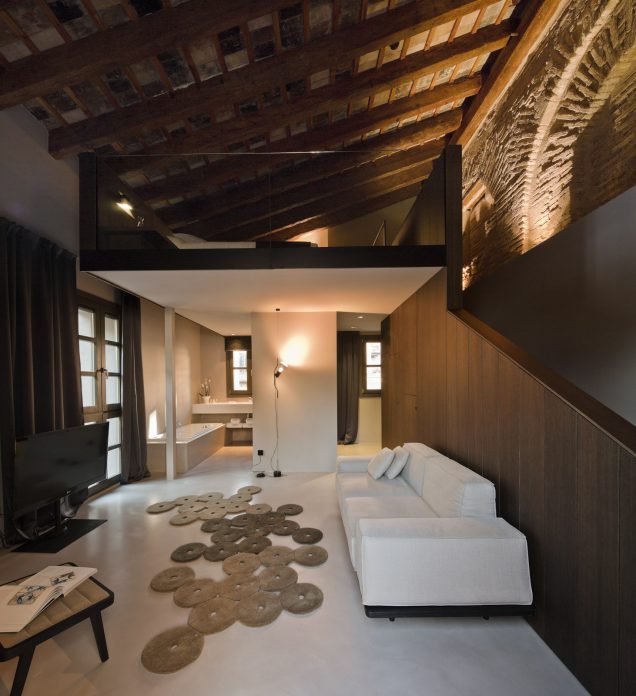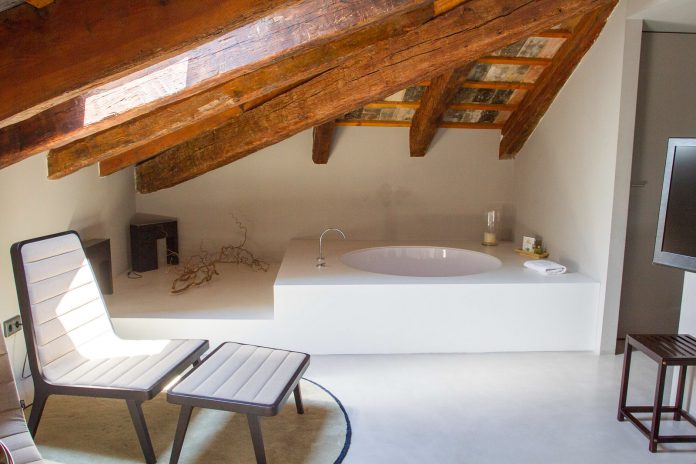During a swift car-oriented visit that took me to the gorgeous Spanish coastal city of Valencia in January, I had the pleasure of staying at one of the city’s most luxurious boutique hotels. Valencia is known for its rich history and picturesque old town, while there is also plenty to admire on the modern side of things. When you consider the mild climate and the abundance of sunshine in both winter and summer, you get yourself a great destination for your next city trip.
The Caro Hotel can be categorized as a one of a kind boutique hotel, breathing Valencia’s culture and heritage in a refined luxury environment. Officially open since 2012, the Caro Hotel promises to be a great alternative to the high-end hotel chains that we find nowadays in any city worth visiting.
History
It all started back in 2005, when the decision was made to transform a more than hundred years old historical building on Valencia’s Calle Almirante into what we now know as the Caro Hotel. Although the building, otherwise known as the “Palace of the Marquis of Caro”, is only about a hundred years old, it has managed to preserve 2,000 years of Valencia’s rich history.
The history of the Palace of the Marquis of Caro brings us back to the year of 1869, the year in which Nicolás García Caro – Valencia’s mayor at the time – purchased the mayor’s residence at a public auction and renovated it in the style of that particular era. Following the purchase, a whole scale renovation project saw both the existing gothic palace and “Casas del Temple” being converted into the palace of the Marquis of Caro.
145 years later, a group of hoteliers purchased the historical property from descendants of Nicolás García Caro and the rest is, literally, history. During the renovation and conversion of the old palace, construction workers stumbled upon the original arches of the old gothic palace. That wasn’t the only thing being unearthed during the building’s lengthy renovation process, as both an original medieval staircase and a part of the old Arabic wall of Valencia were discovered as well.
A little bit of further digging led to the encounter of ashlars, column bases and pieces belonging to the Roman Circus of Valencia, which were still completely intact. Suddenly the property seemed to have preserved artifacts that are about 2,000 years old, making it possibly the oldest construction standing in Valencia. If you still had any doubt about the Caro Hotel being truly unique or special, now is the time to revoke those thoughts.
Location
The Caro Hotel is ideally situated in the heart of Valencia’s historical quarter, the Seu-Xerea neighborhood, just over 200 meters away from Valencia’s main cathedral. The entire historical center and its main sights are just as easy to reach taking you only five minutes by foot. These include Plaza de la Virgen, Plaza de la Reina, Plaza Redonda and Basilica de la Virgen.
As effortlessly as the Caro Hotel provides guests access to Valencia’s historical center, it also enjoys solid connections to the city’s airport (20 minutes by car) and other points of interest in the city such as the “Ciudad de las Artes y las Ciencas” (15 minutes). The latter being one of the city’s most popular sights and something that has really put Valencia on the map in recent years. Designed by “starchitect” Santiago Calatrava, the city of arts and sciences is a world apart from the historical city center. Although strongly contrasting with its historical counterpart, it doesn’t detract from the city’s appearance at all. Functioning as a public park, housing an aquarium and several museums, amongst other things, it’s well worth a visit for both architecture and history enthusiasts.
Back to the direct area surrounding the Caro Hotel, there are several public parking garages for guests that bring their own car. The luxury hotel additionally enjoys the nearby presence of both Valencia’s financial and commercial districts, both taking guests about 10 minutes on foot.
Design
To integrate the building’s cultural and historical legacy, with the appearance and functionality of a contemporary five-star hotel, formed the architectural challenge at hand. With precious historical artefacts being discovered behind every wall, each deserving of the time-consuming consideration of whether they should be preserved and integrated into the hotel or not, it explains the seven years it took to convert the property into a five-star hotel.
In the long run the lengthy renovation projects seemed to have paid off, with the hotel’s architectural uniqueness centering on a rigorous preservation of historical elements blending in nicely with the modern day requirements of comfort, safety and luxury. Architect Francisco Jurado and interior designer Francesc Rifé are responsible for the hotel’s design, having preserved as much of the building’s heritage as possible.
To be able to find and integrate these antiquities, a privately funded archaeological project was set up. The results of the extensive preservation of unearthed ancient gems are very noticeable when inside the Caro hotel. A walk past the hotel’s most cherished objects shows us the oldest mosaic of Valencia, a range of Visigoth remains, parts of the 12th century Arabic Wall, remains of the Gothic palace and many more. Most of the artifacts and structures have been restored and integrated within the hotel, while some are now on display in various museums in the city. The artifacts that were blessed with a permanent stay in the Caro Hotel are mostly in the same position as where they were found.
Some of the archaeological discoveries we find back in the hotel’s common spaces, whilst many of the rooms are similarly decorated using the building’s rich legacy. Situated above the hotel’s bar for instance, which is adjacent to the lobby, we see three ceramic pieces displayed on the wall. Opposite of the bar there are several ancient tiles on display including descriptions. Essentially, the Caro Hotel could be seen as a museum on its own.
In general the interior is quite warm, despite the generous use of glass that was incorporated to expose some of the hotel’s historical highlights. The hotel’s lighting scheme seems to hit just the right angles in an interior that doesn’t enjoy too much natural light, creating that much sought after cozy feeling in boutique hotels. On the particular floor where my room was located, I found myself walking over a glass panel, which revealed a green moss garden beneath that was illuminated appropriately with a spotlight.
Rooms
The diversity and unique aspects of the Caro Hotel continue upon entrance of the room, with each room in the hotel being unique in both layout and décor. The Caro Hotel’s 26 rooms comprise of 6 double rooms, a number of superior rooms and a few “special” rooms. The most luxurious way to stay at the Caro Hotel is booking one of the two suites, the Arabic Tower junior suite and the Marquis suite.
While the double rooms speak for itself, the superior rooms take it up a notch by being an excellent portrayal of Francesc Rifé’s interior design scheme. Glorified with geometric and minimalist interior design and views of the patio or the glass roof covering the restaurant, these are rooms you want to check out if your budget allows it.
Now the special rooms are even more special than the previously mentioned superior rooms. These rooms are where no effort or expense was spared to bring out and display the building’s rich heritage. The special rooms feature 2nd century Roman bases, pieces of Valencia’s Arabic Wall (7th century) and elements of the Gothic Palace (15th century).
The Arabic tower is the smaller suite of the two that the Caro Hotel features. The junior suite is a split-level construction on the same floor as one of the Arabic Wall’s former watchtowers, hence the name. When constructing the junior suite, constructors were able to preserve both the arches that provided access to the original tower and the original beams and joists that were used during the building’s 19th century renovation.
The luxury hotel’s shining star is without a doubt the 80 square meters Marquis suite. It represents the palace’ former most luxury living quarters and incorporates the original ballroom and tearoom as well. To give you an impression of the décor, the ceilings have original paintwork on them while the grand ballroom preserves the original rococo decoration.
My room was situated on the hotel’s fourth floor with a view of the hotel’s patio and lounge pool. The room was one large space, with both a walk-in shower and bathtub. As for the design, the room was finished with a warm blend of taupe and grey colors and a wooden décor. A nice touch was the traditional tile work hanging on the wall above the desk, which we similarly find back opposite of the Meta bar downstairs.
The valuable tiles were just as all other artifacts on display, found at the hotel’s construction site. Dating back from as early as the 18th century, the ceramic artwork displays the gothic rose, the mangrana pomegranate, the sun, vegetable motifs and several examples of a composition called “Merienda en el campo”, or “Picnic in the country”.
Foreseen in all necessities, from Wi-Fi and room service to a mini-bar and full-LED TV, the room was as luxurious as it could be. Even though it was January, the independent air-conditioning system was nothing short of a necessity, in an otherwise comfortable good night’s rest.
In addition to the basics, real luxury is in the details. For instance, a personal room attendant was assigned to me, or how about the small gesture of leaving a detailed weather forecast and a chocolate bar on my pillow after cleaning my room during the small window I was out for dinner? Did I mention that there were a bunch of bathroom amenities courtesy of Bulgari at my disposal as well? Yeah, that comes standard with any room you book at the Caro Hotel, in case you were wondering.
Meta Bar and Alma del Temple Restaurant
The Alma Del Temple restaurant is located on the lower ground floor of the hotel, spanning about 500 square meters in space. Its built on top of the foundations of the Arabic Wall and features a glass roof that let’s in sufficient natural light. While standing on the hotel’s patio, a quick peek through the glass panel revealed an impressive wine cellar and collection, as well as the original stone arches which are so characteristic for the hotel’s style.
The restaurant is divided in three different rooms: the arch room, the Arabic wall and glass panel room, and the private wall room. The arch room has an impressive 15th century Gothic arch presiding over it and has the space to host about 65 guests at a time.
The Arabic wall and glass ceiling area has a light and airy feel to it. It’s located at the entrance of the restaurant, making it more suitable for smaller groups, coffee breaks and cocktail receptions. Tucked away in the back is the private wall room, surrounded by remains of the Arabic wall. It has space for up to 30 people, an excellent space to host private events.
The Meta bar is located in what appears to be an extension of the hotel’s lobby. Leading all the way out to the hotel’s compact patio with lounge pool, the surrounding remains of the Arabic wall make sure that guests are out of the wind making it quite a comfortable place to be. Comforted with terrace heaters and cozy furniture, I enjoyed my time on the patio trying some of the bar’s best cocktails.
I can recommend the bar’s Gin and Tonic, as well as their “Tom Collins” cocktail. With my cocktails came a range of exquisite bites and local delicacies, some of which our very own Mr. FineDining would absolutely approve of.
Conclusion
My stay in the Caro Hotel in Valencia was nothing short of amazing. I found myself wandering around in what is a museum of its own, complimented with a level of service that without a doubt matches its five stars. Is there something that I missed? Well, the obvious absentee is the spa and wellness area that most five star hotels have.
I have to say though; I didn’t really miss that in this particular hotel. The Caro Hotel compensates greatly with their contemporary luxury experience, service and of course the hotel’s design. If you’re looking to experience a luxury city trip to Valencia in a truly unique way, you should look no further. We would like to thank the Caro Hotel for being our host; you can book your stay at www.carohotel.com.





























































